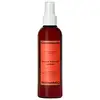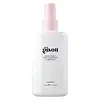What's inside
What's inside
 Key Ingredients
Key Ingredients

 Benefits
Benefits

 Concerns
Concerns

 Ingredients Side-by-side
Ingredients Side-by-side

Water
Skin ConditioningGlyceryl Stearate
EmollientGlycerin
HumectantStearyl Alcohol
EmollientDiheptyl Succinate
EmollientBrassicamidopropyl Dimethylamine
Skin ConditioningCetyl Alcohol
EmollientParfum
MaskingCocos Nucifera Oil
MaskingPhenoxyethanol
PreservativeCapryloyl Glycerin/Sebacic Acid Copolymer
Skin ConditioningBrassica Campestris/Aleurites Fordi Oil Copolymer
Skin ConditioningPersea Gratissima Oil
Skin ConditioningLactic Acid
BufferingPolyquaternium-10
Vp/Va Copolymer
Aloe Barbadensis Leaf Juice
Skin ConditioningEthylhexylglycerin
Skin ConditioningSqualane
EmollientPolyisobutene
Agave Tequilana Leaf Extract
AstringentPsidium Guajava Fruit Extract
AstringentTamarindus Indica Fruit Extract
Skin ConditioningPropanediol
SolventHedychium Coronarium Root Extract
MaskingPectin
Emulsion StabilisingSodium Hydroxypropylsulfonate Laurylglucoside Crosspolymer
CleansingPotassium Sorbate
PreservativeSodium Benzoate
MaskingTartaric Acid
BufferingCitric Acid
BufferingSodium Chloride
MaskingAcrylates/C10-30 Alkyl Acrylate Crosspolymer
Emulsion StabilisingSodium Dilauramidoglutamide Lysine
HumectantCetearyl Alcohol
EmollientStearic Acid
CleansingSodium Lauroyl Glutamate
Carthamus Tinctorius Seed Extract
Skin ConditioningWater, Glyceryl Stearate, Glycerin, Stearyl Alcohol, Diheptyl Succinate, Brassicamidopropyl Dimethylamine, Cetyl Alcohol, Parfum, Cocos Nucifera Oil, Phenoxyethanol, Capryloyl Glycerin/Sebacic Acid Copolymer, Brassica Campestris/Aleurites Fordi Oil Copolymer, Persea Gratissima Oil, Lactic Acid, Polyquaternium-10, Vp/Va Copolymer, Aloe Barbadensis Leaf Juice, Ethylhexylglycerin, Squalane, Polyisobutene, Agave Tequilana Leaf Extract, Psidium Guajava Fruit Extract, Tamarindus Indica Fruit Extract, Propanediol, Hedychium Coronarium Root Extract, Pectin, Sodium Hydroxypropylsulfonate Laurylglucoside Crosspolymer, Potassium Sorbate, Sodium Benzoate, Tartaric Acid, Citric Acid, Sodium Chloride, Acrylates/C10-30 Alkyl Acrylate Crosspolymer, Sodium Dilauramidoglutamide Lysine, Cetearyl Alcohol, Stearic Acid, Sodium Lauroyl Glutamate, Carthamus Tinctorius Seed Extract
Water
Skin ConditioningBehenamidopropyl Dimethylamine
EmulsifyingCetearyl Alcohol
EmollientLactic Acid
BufferingAdansonia Digitata Seed Oil
EmollientArgania Spinosa Kernel Oil
EmollientMel
EmollientSodium Benzoate
MaskingHydroxypropyltrimonium Honey
Panthenol
Skin ConditioningParfum
MaskingHydrolyzed Wheat Protein
Skin ConditioningHydrolyzed Adansonia Digitata Seed Extract
Benzyl Alcohol
PerfumingSaccharomyces/Magnesium Ferment
Sorbic Acid
PreservativeSaccharomyces/Iron Ferment
Skin ConditioningPotassium Sorbate
PreservativeSaccharomyces/Zinc Ferment
Skin ConditioningSaccharomyces/Copper Ferment
Skin ConditioningSaccharomyces/Silicon Ferment
Skin ConditioningCoumarin
PerfumingHexyl Cinnamal
PerfumingLimonene
PerfumingLinalool
PerfumingWater, Behenamidopropyl Dimethylamine, Cetearyl Alcohol, Lactic Acid, Adansonia Digitata Seed Oil, Argania Spinosa Kernel Oil, Mel, Sodium Benzoate, Hydroxypropyltrimonium Honey, Panthenol, Parfum, Hydrolyzed Wheat Protein, Hydrolyzed Adansonia Digitata Seed Extract, Benzyl Alcohol, Saccharomyces/Magnesium Ferment, Sorbic Acid, Saccharomyces/Iron Ferment, Potassium Sorbate, Saccharomyces/Zinc Ferment, Saccharomyces/Copper Ferment, Saccharomyces/Silicon Ferment, Coumarin, Hexyl Cinnamal, Limonene, Linalool
Ingredients Explained
These ingredients are found in both products.
Ingredients higher up in an ingredient list are typically present in a larger amount.
Cetearyl alcohol is a mixture of two fatty alcohols: cetyl alcohol and stearyl alcohol. It is mainly used as an emulsifier. Emulsifiers help prevent the separation of oils and products. Due to its composition, it can also be used to thicken a product or help create foam.
Cetearyl alcohol is an emollient. Emollients help soothe and hydrate the skin by trapping moisture.
Studies show Cetearyl alcohol is non-toxic and non-irritating. The FDA allows products labeled "alcohol-free" to have fatty alcohols.
This ingredient is usually derived from plant oils such as palm, vegetable, or coconut oils. There is debate on whether this ingredient will cause acne.
Due to the fatty acid base, this ingredient may not be Malassezia folliculitis safe.
Learn more about Cetearyl AlcoholLactic Acid is another well-loved alpha hydroxy acid (AHA). It is gentler than glycolic acid but still highly effective.
Its main role is to exfoliate the surface of the skin by loosening the “glue” that holds dead skin cells together. Shedding those old cells leads to smoother, softer, and more even-toned skin.
Because lactic acid molecules are larger than glycolic acid, they don’t penetrate as deeply. This means they’re less likely to sting or irritate, making it a great choice for beginners or those with sensitive skin.
Like glycolic acid, it can:
Lactic acid also acts as a humectant (like hyaluronic acid). It can draw water into the skin to improve hydration and also plays a role in the skin's natural moisturizing factor (NMF) in the form of sodium lactate.
Studies show it can boost ceramide production to strengthen the skin barrier and even help balance the skin’s microbiome.
To get results, choose products with a pH between 3-4.
Lower strengths (5-12%) focus on surface exfoliation; higher strengths (12% and up) can reach deeper in the dermis (deeper, supportive layer) to improve skin texture and firmness over time.
Though it was originally derived from milk, most modern lactic acid used in skincare is vegan. It is made through non-dairy fermentation to create a bio-identical and stable form suitable for all formulations.
When lactic acid shows up near the end of an ingredient list, it usually means the brand added just a tiny amount to adjust the product’s pH.
Legend has it that Cleopatra used to bathe in sour milk to help reduce wrinkles.
Lactic acid is truly a gentle multitasker: it exfoliates, hydrates, strengthens, and brightens. It's a great ingredient for giving your skin a smooth, glowing, and healthy look without the harshness of stronger acids.
Read more about some other popular AHA's here:
Learn more about Lactic AcidParfum is a catch-all term for an ingredient or more that is used to give a scent to products.
Also called "fragrance", this ingredient can be a blend of hundreds of chemicals or plant oils. This means every product with "fragrance" or "parfum" in the ingredients list is a different mixture.
For instance, Habanolide is a proprietary trade name for a specific aroma chemical. When used as a fragrance ingredient in cosmetics, most aroma chemicals fall under the broad labeling category of “FRAGRANCE” or “PARFUM” according to EU and US regulations.
The term 'parfum' or 'fragrance' is not regulated in many countries. In many cases, it is up to the brand to define this term.
For instance, many brands choose to label themselves as "fragrance-free" because they are not using synthetic fragrances. However, their products may still contain ingredients such as essential oils that are considered a fragrance by INCI standards.
One example is Calendula flower extract. Calendula is an essential oil that still imparts a scent or 'fragrance'.
Depending on the blend, the ingredients in the mixture can cause allergies and sensitivities on the skin. Some ingredients that are known EU allergens include linalool and citronellol.
Parfum can also be used to mask or cover an unpleasant scent.
The bottom line is: not all fragrances/parfum/ingredients are created equally. If you are worried about fragrances, we recommend taking a closer look at an ingredient. And of course, we always recommend speaking with a professional.
Learn more about ParfumPotassium Sorbate is a preservative used to prevent yeast and mold in products. It is commonly found in both cosmetic and food products.
This ingredient comes from potassium salt derived from sorbic acid. Sorbic acid is a natural antibiotic and effective against fungus.
Both potassium sorbate and sorbic acid can be found in baked goods, cheeses, dried meats, dried fruit, ice cream, pickles, wine, yogurt, and more.
You'll often find this ingredient used with other preservatives.
Learn more about Potassium SorbateSodium Benzoate is a preservative. It's used in both cosmetic and food products to inhibit the growth of mold and bacteria. It is typically produced synthetically.
Both the US FDA and EU Health Committee have approved the use of sodium benzoate. In the US, levels of 0.1% (of the total product) are allowed.
Sodium benzoate works as a preservative by inhibiting the growth of bacteria inside of cells. It prevents the cell from fermenting a type of sugar using an enzyme called phosphofructokinase.
It is the salt of benzoic acid. Foods containing sodium benzoate include soda, salad dressings, condiments, fruit juices, wines, and snack foods.
Studies for using ascorbic acid and sodium benzoate in cosmetics are lacking, especially in skincare routines with multiple steps.
We always recommend speaking with a professional, such as a dermatologist, if you have any concerns.
Learn more about Sodium BenzoateWater. It's the most common cosmetic ingredient of all. You'll usually see it at the top of ingredient lists, meaning that it makes up the largest part of the product.
So why is it so popular? Water most often acts as a solvent - this means that it helps dissolve other ingredients into the formulation.
You'll also recognize water as that liquid we all need to stay alive. If you see this, drink a glass of water. Stay hydrated!
Learn more about Water